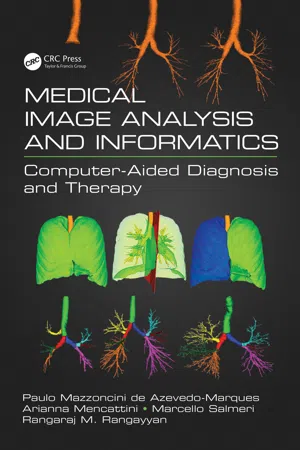
Medical Image Analysis and Informatics
Computer-Aided Diagnosis and Therapy
- 518 pages
- English
- ePUB (mobile friendly)
- Available on iOS & Android
Medical Image Analysis and Informatics
Computer-Aided Diagnosis and Therapy
About This Book
With the development of rapidly increasing medical imaging modalities and their applications, the need for computers and computing in image generation, processing, visualization, archival, transmission, modeling, and analysis has grown substantially. Computers are being integrated into almost every medical imaging system. Medical Image Analysis and Informatics demonstrates how quantitative analysis becomes possible by the application of computational procedures to medical images. Furthermore, it shows how quantitative and objective analysis facilitated by medical image informatics, CBIR, and CAD could lead to improved diagnosis by physicians. Whereas CAD has become a part of the clinical workflow in the detection of breast cancer with mammograms, it is not yet established in other applications. CBIR is an alternative and complementary approach for image retrieval based on measures derived from images, which could also facilitate CAD. This book shows how digital image processing techniques can assist in quantitative analysis of medical images, how pattern recognition and classification techniques can facilitate CAD, and how CAD systems can assist in achieving efficient diagnosis, in designing optimal treatment protocols, in analyzing the effects of or response to treatment, and in clinical management of various conditions. The book affirms that medical imaging, medical image analysis, medical image informatics, CBIR, and CAD are proven as well as essential techniques for health care.
Frequently asked questions
Information
Characterization of White
Matter Lesions in FLAIR
Magnetic Resonance
Imaging
Table of contents
- Cover
- Half-Title
- Title
- Copyright
- Dedication
- Contents
- Foreword on CAD: Its Past, Present, and Future
- Preface
- Acknowledgements
- Editor bio
- Contributors
- 1 Segmentation and Characterization of White Matter Lesions in FLAIR Magnetic Resonance Imaging
- 2 Computer-Aided Diagnosis with Retinal Fundus Images
- 3 Computer-Aided Diagnosis of Retinopathy of Prematurity in Retinal Fundus Images
- 4 Automated OCT Segmentation for Images with DME
- 5 Computer-Aided Diagnosis with Dental Images
- 6 CAD Tool and Telemedicine for Burns
- 7 CAD of Cardiovascular Diseases
- 8 Realistic Lesion Insertion for Medical Data Augmentation
- 9 Diffuse Lung Diseases (Emphysema, Airway and Interstitial Lung Diseases)
- 10 Computerized Detection of Bilateral Asymmetry
- 11 Computer-Aided Diagnosis of Breast Cancer with Tomosynthesis Imaging
- 12 Computer-Aided Diagnosis of Spinal Abnormalities
- 13 CAD of GI Diseases with Capsule Endoscopy
- 14 Texture-Based Computer-Aided Classification of Focal Liver Diseases using Ultrasound Images
- 15 CAD of Dermatological Ulcers (Computational Aspects of CAD for Image Analysis of Foot and Leg Dermatological Lesions)
- 16In Vivo Bone Imaging with Micro-Computed Tomography
- 17 Augmented Statistical Shape Modeling for Orthopedic Surgery and Rehabilitation
- 18 Disease-Inspired Feature Design for Computer-Aided Diagnosis of Breast Cancer Digital Pathology Images
- 19 Medical Microwave Imaging and Analysis
- 20 Making Content-Based Medical Image Retrieval Systems Worth for Computer-Aided Diagnosis: From Theory to Application
- 21 Health Informatics for Research Applications of CAD
- Concluding Remarks
- Index